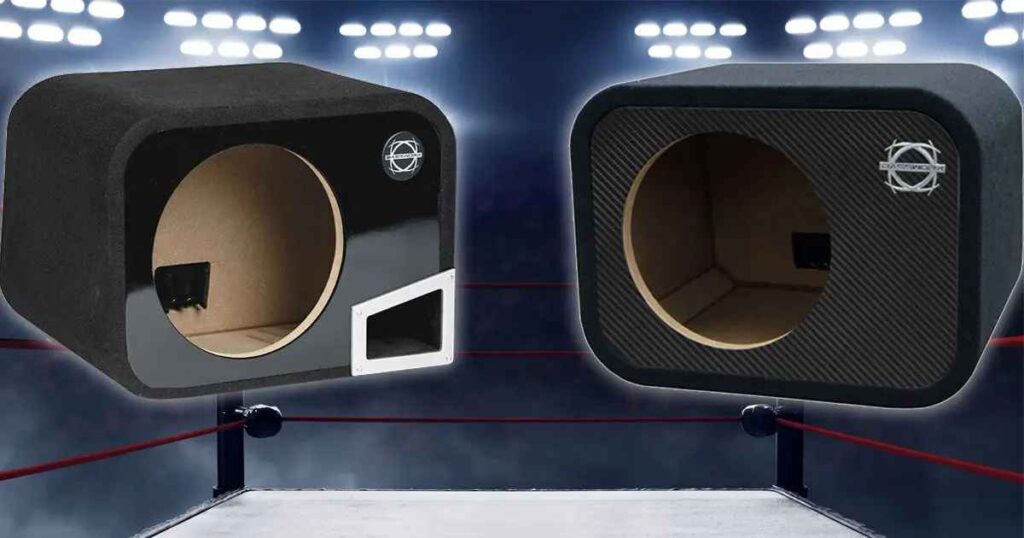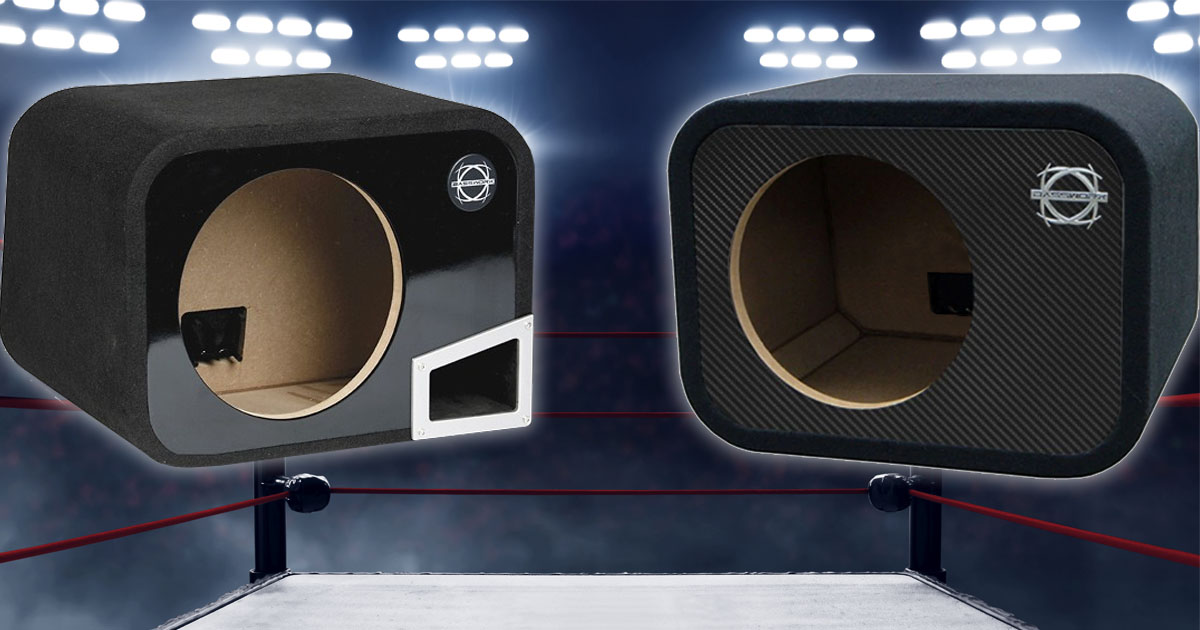When it comes to car audio subwoofer enclosures, the two most popular options are sealed or vented. As far as which design is best for your vehicle, let’s see if we can clear up some misconceptions and stereotypes. As often happens, some trade-offs accompany each decision. Consider this article the master reference for choosing the right subwoofer enclosure solution for your application.
Why Does a Subwoofer Need an Enclosure?
Let’s review a few key factors about subwoofers (and speakers in general). First and foremost, the primary purpose of a subwoofer enclosure is to prevent the sound that’s coming off the back of the speaker cone from mixing with the sound coming from the front. If these two mix, they cancel each other out almost perfectly. If you’ve ever held a subwoofer in your hand without an enclosure while it’s playing, you’ll know it doesn’t produce much sound.
Second, an enclosure acts as a mechanical high-pass filter that limits low-frequency output. Why do we need to limit bass from a subwoofer? As frequency decreases, cone excursion increases dramatically to produce an equivalent output. In fact, for every halving of frequency, cone excursion doubles.
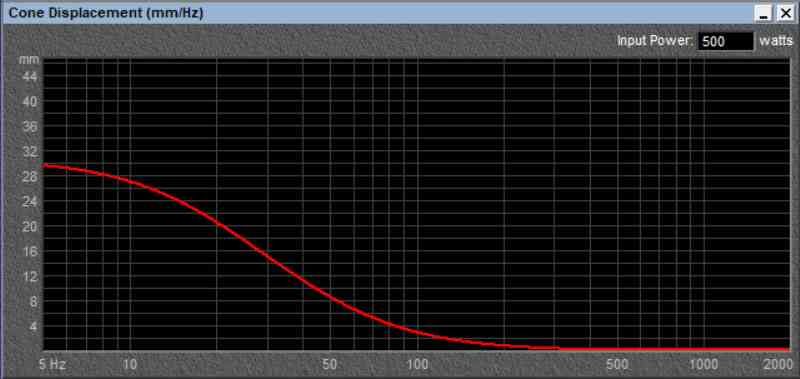
The simulation above shows the predicted cone excursion (in millimeters) of an audiophile-grade 10-inch subwoofer without an enclosure. This is a great driver, and it has an Xmax specification of 19 mm. As such, at frequencies below 22 hertz, when driven with 500 watts of power, the distortion would skyrocket. If we increase the power to the subwoofer to 750 watts, that frequency increases to 28 hertz. At a drive level of 1,000 watts, the driver will reach its Xmax limit at 33 hertz.
Many subwoofers don’t have this much excursion capability, so we need to limit the distance the cone can move. We install the subwoofer in an enclosure so that the air in the enclosure combines with the suspension of the driver to limit cone motion. More specifically, we are adding the stiffness of the air spring in the enclosure to the stiffness of the subwoofer suspension (spider and surround) to make the net system stiffer. Here’s the predicted cone excursion of this driver in the manufacturer-recommend 0.6-cubic-foot enclosure.
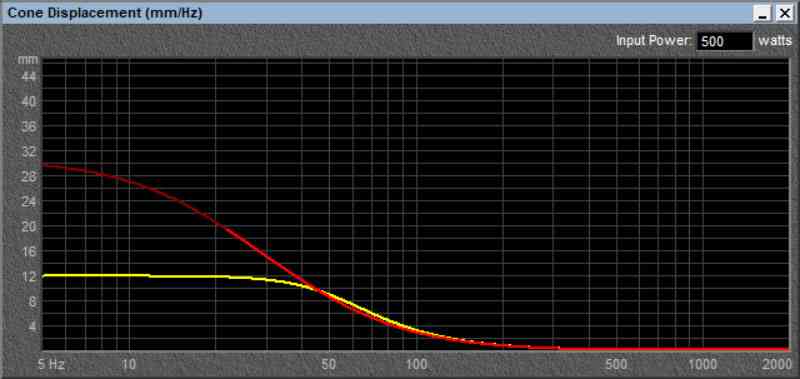
This second graph shows that the driver’s excursion is limited to about 11.7 millimeters when driven with 500 watts. Excursion increases to only 16.5 millimeters at the lowest frequencies when fed 1,000 watts. In this enclosure, cone excursion is no longer an issue.
The trade-off for limited cone excursion is a decrease in output capability. The graph below shows the predicted frequency response of our subwoofer system in the infinite baffle simulation and the small sealed enclosure.
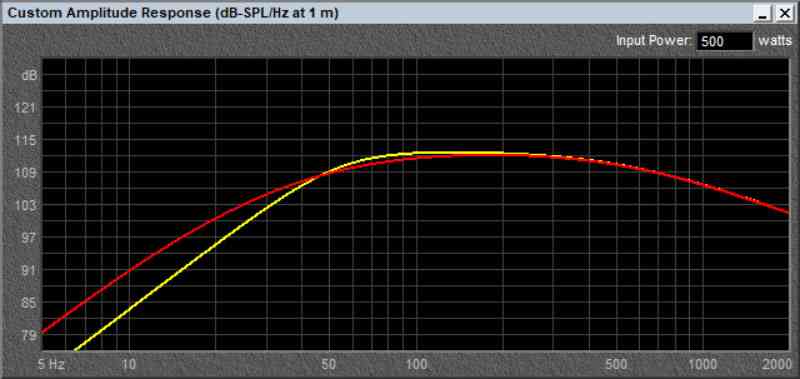
Below 47 hertz, the infinite baffle driver becomes more efficient. For example, at 25 Hz, it’s 3.6 dB louder in the infinite baffle.
Subwoofer Cone Excursion and Distortion
More output seems ideal, as long as we are below the Xmax limit, right? Well, yes and no. Every moving coil speaker produces more distortion as cone excursion increases. In addition, variations in suspension compliance (the inverse of stiffness) and magnetic field strength mean that the cone may not track the input signal accurately at high excursion levels. Given the above considerations, we want to limit cone excursion whenever possible. As such, more or larger diameter subwoofers in a system can improve sound quality, as long as each is in a correctly designed enclosure.
Let’s add the bass reflex (also known as ported or vented) enclosure to the mix. A vented enclosure is similar to our sealed enclosure, except it has a tube (or square, triangle or rectangle) with a specific length and area. The vent is a Helmholtz resonator. What’s that? Have you ever blown across the top of a bottle of pop (OK, soda) to hear it hum? That’s a Helmholtz resonator. The resonant frequency is lower if you drink some of the pop and blow again. This is because you’re exciting the air in the chamber, and it resonates at a specific frequency. Helmholtz resonators are used on the intact ducting and exhaust systems of cars to cancel out resonances in the system.
In a vented subwoofer enclosure, the vibration from the subwoofer cone causes the column of air in the vent to resonate. At a specific frequency, called the tuning frequency, the resonance in the vent is maximized. As a result, the vent now acts as the primary sound source for the enclosure, and output from the subwoofer cone itself is minimal. Here’s the cone excursion graph of our audiophile-grade 10-inch subwoofer in a 1-cubic-foot vented enclosure that has a vent tuned to resonate at 33 hertz.
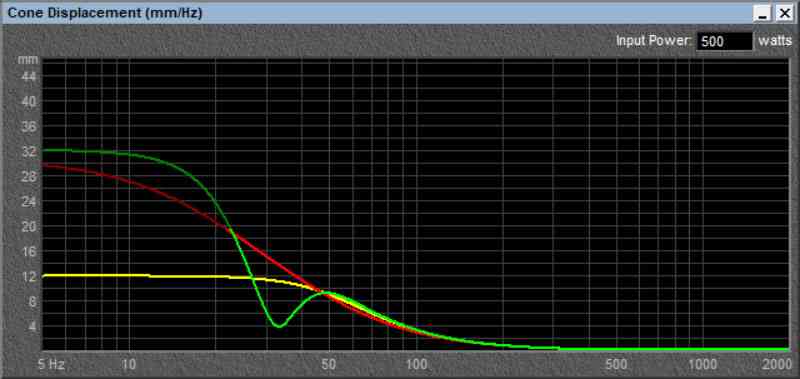
We can see that cone excursion is dramatically increased around the tuning frequency of 33 hertz. It increases slightly at 60 hertz, but in this design, that’s inconsequential. What does matter is that the vent acts like a hole in the enclosure at low frequencies, and cone excursion increased dramatically below 27 hertz. If we want to maximize the output of the system, the use of an electronic infrasonic filter will be necessary at 25 hertz.
What’s the benefit of our vented enclosure, then? Here’s the predicted output graph.
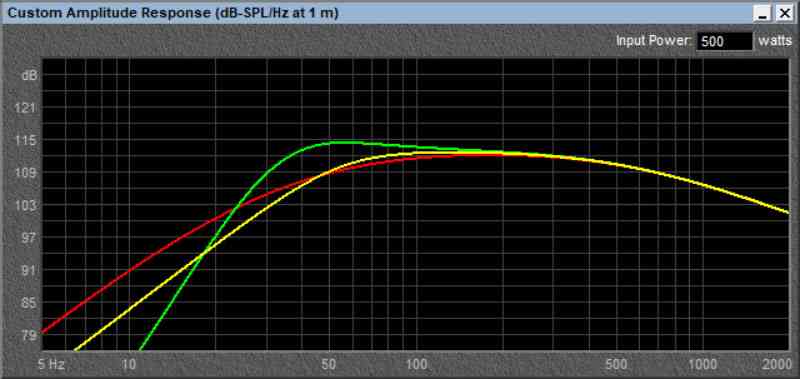
As you can see, we gained an impressive 6.5 dB of output at 40 hertz for the same input power. We’d need to drive the sealed subwoofer with 2,235 watts to produce the same output. For many reasons, including the risk of fire, that won’t work.
Sealed vs. Vented – Enclosure Size
In the case of this example, the sealed enclosure has a net internal air volume of 0.6 cubic foot. Our vented enclosure is 1 cubic foot. Translated into dimensions, the outside dimensions of the sealed enclosure, constructed of ¾-inch MDF, would be (as an example) 12 by 12 by 11.75 inches. The vented enclosure would need to be 12 by 12 by 18.2 inches. That’s an increase in length of more than 50%. If you need a small enclosure to fit in a specific space, sealed might be your only option.
Sealed vs. Vented – Efficiency
Comparing the two enclosures above clarifies that the vented design is significantly louder at all frequencies above 18.5 hertz. So, if you’re looking for the most output from a system with a small amplifier, then a vented enclosure is the best choice. The vented enclosure is the best choice if you’re after the loudest system.
Sealed vs. Vented – Sound Quality
When it comes to outright sound quality, choosing your enclosure is more complicated. We’ll need to start by looking at what happens when we put these enclosures into a vehicle. The graph below shows two traces for each enclosure. The lower trace of each color is the free-field predicted response, and the second trace includes an approximation of the response of the system in a car or SUV. This in-car response information is based on data that Boston Acoustics included with one of their drivers in the BassBox Pro simulation software I use. I’ve seen in-car graphs from other sources that are similar, so this is adequate for our purposes.
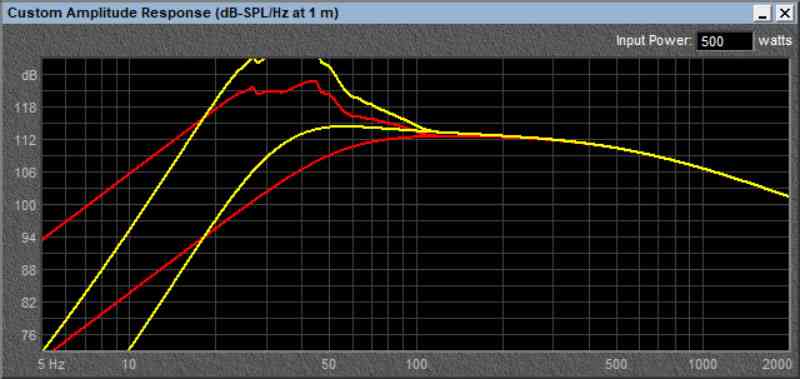
As you can see, at low frequencies, based on the provided information, a significant amount of boost is added. It’s on the order of more than 20 dB SPL below 30 hertz. What looked like a smooth, flat response from the vented enclosure now has a prominent peak from 30 to 45 hertz. What looked like somewhat limited output from the sealed enclosure appears reasonably flat.
Here’s the answer to choosing sealed or vented for sound quality. If the system doesn’t have an equalizer to flatten the response, then a sealed enclosure would be better. If the system does have an equalizer, then choose a vented enclosure. Why choose the vented design when there is an EQ? Well, you can flatten the response and dramatically reduce the power required from your amplifier to hit a target response curve. More importantly, cone excursion will be decreased dramatically with the vented enclosure so that less distortion will be added to the sound produced by the subwoofer.
One quick note: For the last statement to be true, the vent in the enclosure needs to be designed and executed correctly. That’s a topic for an entirely different article.
Sealed vs. Vented – Infrasonic Performance
Many people really like deep bass. I’m not talking about 25 or 30 hertz; I mean 10 to 15 hertz bass. The kind that you don’t hear but feel in your back and behind. If that’s your cup of tea, then a sealed enclosure might be the better option for your car audio system.
Sealed vs. Vented – Limited Xmax Subwoofers
If you want to have an enclosure constructed for a subwoofer with limited excursion capability, you might want to consider the vented design. This might be an entry-level subwoofer with a short magnetic field or a shallow-mount subwoofer.
Sealed vs. Vented – Enclosure Construction Cost
This one will be up to the specialty mobile enhancement retailer you’re working with. The cost of constructing a vented enclosure is likely higher than for a sealed design. With that said, the performance benefits may offset this cost. You might want to read our article about choosing subwoofer sizes as a single 12 in a vented enclosure might outperform two 10-inch subs in a sealed enclosure. The net cost should be much less. Talk to the product specialist you’re working with and have them do some simulations with the drivers you have in mind.
Pick Your Priorities, Then Pick Your Enclosure
There you go – a whole slew of reasons why you might pick a sealed enclosure or a vented one for your car audio subwoofer. Depending on your application and expectations, there isn’t a clear winner. Make a list of what you want from a subwoofer, then cross-reference those criteria with the answers above. If you reach a stalemate, prioritize your criteria and repeat the process. Your local specialty mobile enhancement retailer should have no problem delivering a solution that will sound great based on that list.
This article is written and produced by the team at www.BestCarAudio.com. Reproduction or use of any kind is prohibited without the express written permission of 1sixty8 media.

